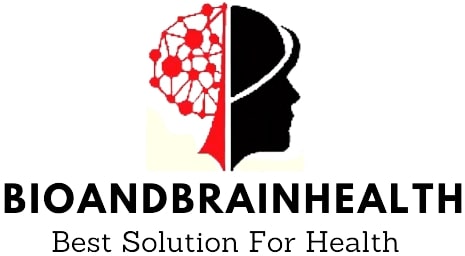Please read this Acute aortic dissection, Aortic artery dissection, Aortic dissection disease, Aortic dissection treatment, Aortic dissection symptoms.
Acute aortic dissection. Dissecting aortic aneurysm, dissecting aneurysm, 1 type of aortic dissection, aortic tear.
Consult your healthcare practitioner if you have any signs of a respiratory system issue while taking this prescription medication. This should be done before you decide to stop taking antiarrhythmic medication on your own.
Aortic dissection disease will cause intensive injury to numerous organs and instantaneous death and may perpetually be thought of as a medical emergency.
Please read this blog: eight-benefits-of-crying-why-its-good-to-shed-a-few-tears
What is a dissecting aortic aneurysm?
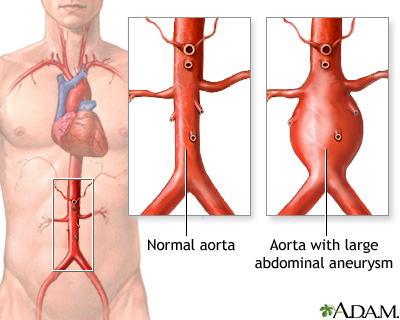
There is a tear in the wall of the aorta, which is the principal artery that connects the heart to the rest of the body and is responsible for transporting blood throughout the body.
Aortic dissection disease This tear is known as a dissecting 1aortic aneurysm.
This can cause blood to flow into the area between the artery wall’s layers, which will result in the aorta being dissected.
An aneurysm of the Aortic dissection disease is a dangerous disorder that results in problems that could be fatal. Several symptoms may be linked to a dissecting aortic aneurysm.
These symptoms include Aortic dissection disease, chest pain, back pain, stomach pain, shortness of breath, dizziness, weakness, nausea, and nausea.
If you have any of these symptoms, it is crucial that you promptly seek medical care. An untreated dissecting aortic aneurysm is a critical medical emergency with the potential to be fatal.
Surgical intervention is often required to restore the damaged artery when a Aortic dissection disease aneurysm is being treated. In some instances, a stent may be inserted to support the artery.
After treatment with Aortic dissection disease, it is essential to monitor the aorta for any further damage or dissecting aneurysms.
If you or someone you know has a history of cardiovascular disease, it is essential to be aware of the signs and symptoms of a dissecting aortic aneurysm and to seek medical attention immediately if any occur.
Please read this blog post how-to-deal-with-sudden-anxiety
The category or classification An Aortic dissection disease is a life-threatening condition that happens when the inner layer of the aorta, the main blood vessel that carries oxygen-rich blood from the heart to the body, tears apart.
This may result in the detachment of the inner layer from the outer layer, generating a gap between them.
This may result in the interstitial flow of blood exerting pressure on the external layer and causing its structural integrity to diminish .Aortic dissection disease.
Type 1: Acute aortic dissection
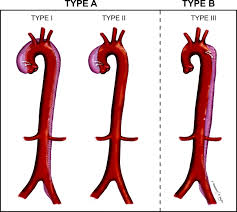
is a critical medical condition that, if not promptly addressed, may lead to severe outcomes. The following are some of the symptoms associated with type A aortic dissection: intense chest discomfort that may spread to the back, jaw, or arms.
Insufficiency of breath, a racing heart, lightheadedness or dizziness, weakness, or paralysis in the arms or legs are among the symptoms that may be experienced.
an unforeseen decline
You must seek immediate medical assistance if you have any of these symptoms. A CT scan or an MRI to identify type A aortic dissections is standard practice.
Surgery to repair the aorta is often required as part of the treatment for type A aortic dissection when it is present. Medication may also be used to assist in regulating both the heart rate and blood pressure.
Without timely medical attention, type A 2aortic dissection is a dangerous disorder that has the potential to result in death. You must seek immediate and appropriate medical assistance if you have any of the symptoms above.
If it is not treated promptly, an aortic tear is a dangerous medical ailment that has the potential to result in death. A rupture or tear in the aorta, which is the primary artery in the body, is the cause of this condition.
This has the potential to produce severe internal bleeding as well as harm to organs.
The most common cause of aortic tears is a rapid spike in blood pressure, which various factors, including a fall or a vehicle accident, may bring on.
A long-standing tear in the aorta is another potential cause of them. Treatment for an aortic tear typically includes surgery to repair the tear and medications to control blood pressure.
Aortic tears are a medical emergency and require immediate treatment.

Suppose you suspect that you or someone you know could be experiencing an aortic tear. In that case, it is imperative to immediately contact emergency services by dialing 911 or promptly go to the closest emergency facility.
Please read this blog: what-happens-if-you-take-3-gummies-of-melatonin
An aortic tear is a rupture or damage in the aorta, the main artery that carries blood from the heart to the rest of the body. Acute aortic dissection.
An aortic tear, if left untreated, may pose a grave medical threat and have fatal consequences. A rupture or tear in the aorta, which is the primary artery in the body, is the cause of this condition.
This has the potential to produce severe internal bleeding as well as harm to organs.
The most common cause of aortic tears is a rapid spike in blood pressure, which various factors, including a fall or a vehicle accident, may bring on.
A long-standing tear in the aorta is another potential cause of them.
Causes
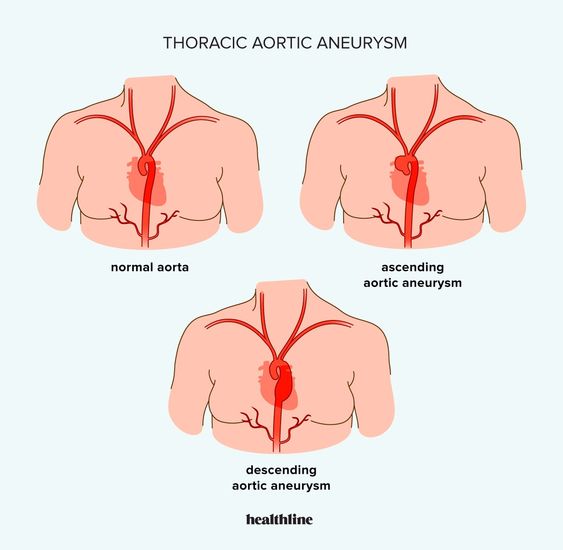
Acute aortic dissection happens once the outer layer of the arterial wall becomes weakened, permitting a tear to be created.
Acute dissection: aortic dissection. This weakening is typically associated with high blood pressure.
Scleroderma, Marfan syndrome, Turner syndrome, Ehlers-Danlos syndrome, traumatic damage, and inflammation of the blood vessels are only a few conditions in which this phenomenon has been seen in animal tissues.
Acute aortic dissection is additionally caused by problematic drug use.
It is more common for males than it is for women to have an acute aortic dissection, which often occurs in people who are between the ages of fifty and seventy if they are in their later years.
Please read this blog titled manic-phase-of-bipolar-disorder
Arterial Dissection:
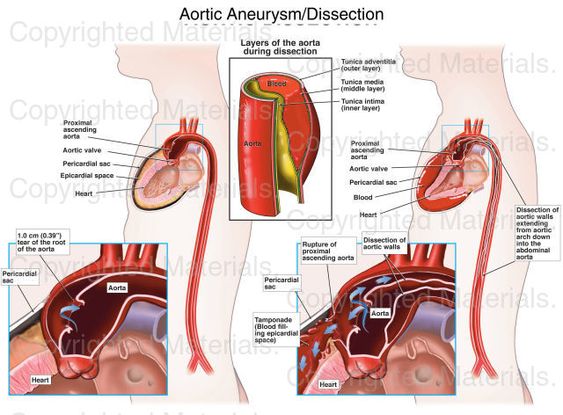
A Description of Acute Aortic Dissection Arterial dissection occurs when blood pressure from below pushes on the arterial wall, causing the artery wall’s layers to rip apart.
After a significant injury, much blood will rush into the arterial wall and be lost to the body.
Acute aortic dissection: The blood slicing through the artery will traverse the length of the artery, blocking the branches that branch out of the artery and causing damage to the organs that rely on them to function.
Acute aortic dissection can lead to arteria regurgitation, serous membrane effusion, infarction, symptoms in other medical fields, failure, and damage to the duct.
Moreover, the acute aortic dissection will rupture the artery fully, resulting in enormous internal harm.
For these reasons, the mortality rate with acute aortic dissection, even with fast and aggressive treatment, is high.
Symptoms: acute aortic dissection

Most ordinarily, acute aortic dissection causes the abrupt onset of a sharp, severe, “tearing” pain within the chest or back that always radiates to the abdomen.
Additionally, syncope—a brief loss of consciousness—significant shortness of breath, or signs of a severe stroke—may follow the pain associated with acute aortic dissection.
Generally, the symptoms of acute aortic dissection are so horrifying and severe that there’s a tiny question within the victim’s mind concerning whether or not immediate medical assistance is required.
Please read this blog post can-anxiety-increase-blood-pressure
An acute dissection of the aorta is the treatment.

The available treatment options vary depending on the ailment and the region.
In all cases, patients with acute aortic dissection units are dropped at the medical aid unit and area unit and placed on endovenous medications (usually with nitroprusside) to reduce their pressure level considerably.
Acute aortic dissection: Lowering the pressure level will slow the continuing dissection of the artery wall.
Beta-blockers (propranolol or labetalol) are administered intravenously to these individuals to reduce their heart rates and pulse power.
Acute aortic dissection: This measure is used to prevent the need for further dissection.
When the patient’s vitals are stable enough, an ancillary imaging investigation (usually a CT scan or MRI) is carried out to determine which section of the artery is at risk. Depending on where it is found, blood types and groups are both names for the same dissection.
Type A Dissections: acute aortic dissection
blood type acute aortic dissection area unit seen within the ascending artery (the early part of the aorta that provides blood to the center, the brain, and also the arms).
The blood type dissection area unit is sometimes treated with surgical repair, which sometimes consists of removing the broken part of the artery and replacing it with a Terylene graft.
While not undergoing surgery, these patients are at extraordinarily high risk for arteria regurgitation, infarction, or stroke and sometimes die from such complications.
Operations are complex and intricate. However, surgical procedures have a thirty-fifth increased chance of death. Thus, blood-type dissections are best treated with surgical intervention.
Unfortunately, with dissection, even with medical intervention, the death rate is rather significant.
Blood group B dissections are restricted to the descending artery, the portion of the aorta located before the spine that supplies blood to the abdominal organs and the legs.
In these cases, acute aortic dissection mortality isn’t measured and will be higher with surgery than with treatment.
Thus, treatment for acute aortic dissection typically consists of continuous medical care, that is, continued pressure level management and beta blockers.
However, if acute aortic dissection is harmful to the kidneys, viscus tract, or lower extremities, surgery might become necessary.
Recovery: acute aortic dissection
After the acute arteria dissection has been treated, the convalescent patient should stay on beta blockers for the remainder of their life, and excellent pressure level management may be a must.
Repeat MRI scans of the area unit are performed before hospital discharge, sometimes over the ensuing year, and each one to 2 years. Sadly, this follow-up is essential as a result.
Acute aortic dissection: unfortunately, 25 percent of those who survive acute aortic dissection may need to have further surgery for persistent acute aortic dissection in the years that follow.
Because acute aortic dissection is at least as life-altering, if not fatal, it’s much better to stop it than to treat it.
You’ll be able to cut back your odds of getting arteria dissection by paying attention to your vessel risk factors, having exceptionally high blood pressure, and dealing sharply to enhance your risk profile.
Final Thought
If you think you are experiencing the symptoms of an aortic dissection, it is vital to seek medical attention right away.
Prompt diagnosis and treatment are essential for preventing serious injury or death.
Although acute aortic dissection can be deadly, many people who receive prompt treatment survive.
If you have any inquiries or want further details on aortic dissections, please get in touch with me without hesitation.
